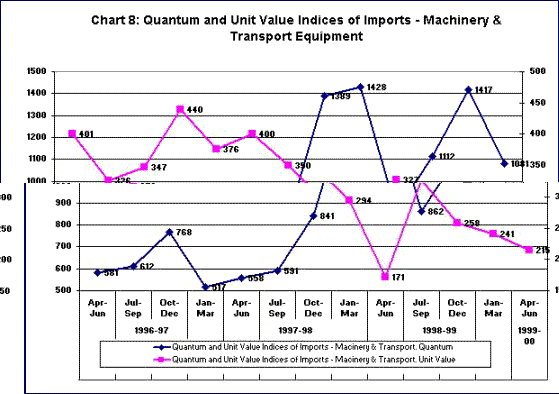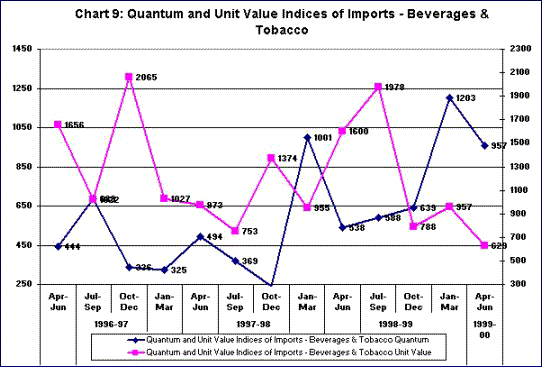This
would imply that in periods of rising demand, firms
would accumulate inventories of imported components
and intermediates. Given the fact that components
and spares for capital are included in the "capital
goods" category in import data, periods of such
accumulation of inventories would also be periods
in which the imports of "capital goods"
would register an increase. The years 1994-95 to 1996-97
were years when as a result of the release of the
pent-up demand for import-intensive manufactured goods,
there was a "min-boom" in industry, which
would have resulted in a sharp increase in capital
goods in the forms of components of various kinds.
In fact, qualitative evidence suggests that there
was not just such an increase, but that the expectations
created by the mini-boom resulted in the excess accumulation
of such inventories, which firms were hard put to
reduce once the market created by a pre-existing pent-up
demand was exhausted. Thus the quantum indices of
capital goods provided in Chart 7, which point to
a sharp increase in imports in 1994-95, reflect in
all probability this tendency rather than the effects
of a decline in prices. It is also not surprising,
therefore, that once inventories were accumulated
and demand for the final good tapered off, such imports
fell sharply and stabilised at a low level. The recession
rather than price has finally put restraints on the
run-away increase in imports of 'capital goods'.
That this could be a valid explanation is suggested
by the experience with Chemicals, were as Chart 8
shows, both unit value indices and prices have risen
for most years during the 1990s. While the experience
in 1989-90, 1995-96 and 2000-01 suggests that the
import demand for chemicals is indeed price sensitive,
price changes are hardly the explanation for trends
in imports, which must come from the demand side.

Chart
8 >> Click
to Enlarge
Import
prices could, however, have had an effect on import
trends in other commodities, which do not share these
characteristics of capital goods or chemical imports.
One such group of commodities is Food and Food Articles.
As Chart 9 shows, the unit value index of Food and
Food Articles rose significantly between 1990-91 and
1994-95, fell sharply thereafter till 1999-00 and
rose in 2000-01. The quantum of imports on the other
hand, fluctuated around a stagnant trend during the
first of these periods, rose sharply between 1995-96
and 1998-99 and has fallen quite significantly over
the next two years. The price elasticity of demand
has possibly played a role here ensuring that imports
rose only when prices were low and fell in response
to price increases so as to keep prices in control.
The reason why the price factor has been so important
here is that "sticky" imports, which occur
irrespective of the price level, are no more a major
component of food imports.

Chart
9 >> Click
to Enlarge
These "sticky" imports are primarily those
made by official agencies to counter domestic shortages
and the inflation they engender. Two factors have
contributed to a decline in the share of such imports.
First, a combination of consecutive normal or good
monsoons and a slow growth in demand that has substantially
eased the availability of many food items, especially
foodgrains, reducing the need for imports to meet
shortfalls. Second, the fact that import liberalisation
has contributed to the dampening of upward movements
in domestic food prices over the long run, reducing
the need for anti-inflationary imports.
To sum up, despite liberalisation and the stagnation
or slow growth of India's exports since the mid-1990s,
India's balance of trade deficit has not worsened
because of the sluggishness of aggregate import growth
in years when oil prices have been subdued. Two factors
seem to have combined to deliver this result. First,
the observed price elasticity of demand for imported
food and food articles, which keeps the import bill
on this account under control. Second, the sluggishness
in the economy in general and the industrial sector
in particular after 1995-96, which has resulted in
a tapering off and even decline in the demand for
a range of manufactured intermediates. This has meant
that the trade deficit tends to widen significantly
only when oil prices rise, since the demand for oil
and oil products is substantially price inelastic.
Thus there appear to be only two circumstances that
can lead to a substantial rise in the import bill.
First, a recovery and sustained growth in industrial
production. And second, a sharp rise in oil prices.
If either of these occurs, the trade deficit is bound
to widen, unless India is able to make the breakthrough
in world markets that the liberalisation was expected
to deliver and has not.
In the meanwhile, a contained deficit, combined with
large inflows of remittances, deposits, debt and investment
have created a situation where India's foreign exchange
reserves have increased substantially to touch the
record levels at which they stand at present.

